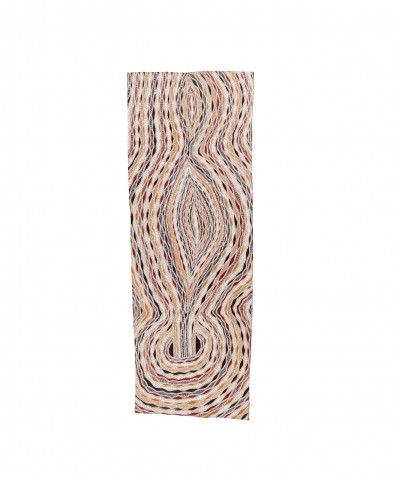BARALTJPA, 2013
DJAMBAWA MARAWILI
natural earth pigments on eucalyptus bark
235.0 x 80.0 cm (irregular)
Buku–Larrnggay Mulka Arts, Yirrkala, Northern Territory (cat. 4314C) (label attached verso)
Vivien Anderson Gallery, Melbourne
Maclean collection, Melbourne, acquired from the above in May 2013
Djambawa Marawili AM: Master of Ceremony, Vivien Anderson Gallery, Melbourne, 17 April – 11 May 2013, cat. 4
This work is accompanied by a certificate of authenticity from Buku–Larrnggay Mulka Arts, Yirrkala which states: ‘Baraltja is the residence of Burrut'tji (also known as Mundukul) the lightning serpent. It is an area of flood plains that drain into northern Blue Mud Bay. It is on country belonging to the Madarrpa and denotes an area of special qualities pertaining to fertility and the mixing of waters. From Madarrpa (and Dhalwaŋu clan) land freshwater spreads onto the Baraltja flood plains with the onset of the Wet. A tidal creek into the Bay flows with the freshwater flushing the brackish mix into the sea over an ever shifting sandbar (the snake manifest).
Freshwater enters the tidal mud flats at Baraltja that is residence of the Lightning Snake for the Madarrpa. The lightning Snake facing upstream, upon tasting the freshwater coming down stands on his tail and by way of spitting lightning into the sky communicates with the Ŋuŋurrdulpuyŋu and his contemporaries from other associated clans. The same can be said for the other who faces towards the south towards another Madarrpa area called Guminiyawiny, Numbulwar way, producing storm fronts and boomerang shaped jet streams with its message. These events are sung with the aid of Napunda the boomerang shaped click sticks that are represented by the same shapes of the jet–steams that feather the storms front. Songs associated with Baraltja are normally intoned at the completion of men's ceremonv for the Madarroa and associate clans.
Waŋupini or thunderheads are seen flicking lightning on the horizon in the deep water named Muŋurru connecting with Madarrpa ancestors of the Dhiliyalyal tribe who lived at Boway Ŋipaŋwuy further down the coast. This Ancestral kinship tie is linked over sea country as well as the land and a cycle of events that also connect by lightning wind and rain has it so. The cloud is sung as femininity and fecundity, pregnant with life–giving freshwater.
So as a harpoon travels or does lightning the estates are connected spiritually in a multi directional way – both to and from, a cyclic phenomenon which is chronicled in the sacred songs that narrate these Ancestral actions over land, through the sea and ether. It is worth noting that Yolŋu 'science' portrays this energy burst as coming up from the land which is now recognised by Western science as the precursor to downward lightning 'strikes'.
From this beach Ancestral Hunters on seeing Dugong took their hunting harpoon and canoe out to the sea of Yathikpa in pursuit. The hunters were lured too close to a dangerous rock by the dugong seeking shelter. The dugong here feed on the Gamata, a sea grass that is a manifestation of flames on the sea bed. Wavy ribbons of seagrass sway in the sunlit water. Fire at this sacred site boiled the water capsizing the canoe. This is sometimes called an ancestral tide and it is speculated that this is the oral tradition of an ancient tsunami which initiates death and founds existing mortuary ceremonies in the region like the sacred sand sculpture yinapunapu which is a canoe shaped space which holds the contamination of decay at bay. The sacred harpoon changed into Dhakandjali the hollow log coffin/memorial pole that floats on the seas of Yathikpa and further afield within Blue Mud Bay, its directions connecting other Yirritja clans (Maŋgalili and Dhalwaŋu) through association of kin across the Bay.’
